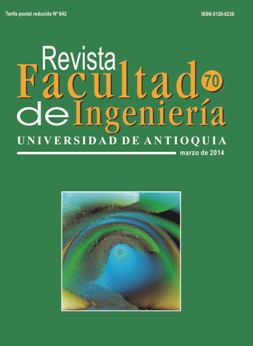Low cost heat-and-pull rig for manufacturing adiabatic optical fiber tapers
DOI:
https://doi.org/10.17533/udea.redin.14820Keywords:
optical fiber, tapering, adiabaticity, sensorsAbstract
In this paper we report the fabrication of adiabatic tapered optical fbers using a low cost heat-and-pull rig. Our setup is based on the flame-brushing technique moving in zigzag, where an inexpensive and simple portable gas micro-torch is used as heating device. Since this method does not require an electronic system to control the gas flow rate, makes out taper rig an attractive alternative, low-cost, and trivial to implement. The feasibility of such a heat source is shown with the manufacture of low-loss tapers (<0.12 dB/mm) and diameters in the micro range.
Downloads
References
E. Udd, W. Spillman. Fiber optic sensors: an introduction for engineers and scientists. 2nd ed. Ed. Wiley. New Jersey, USA. 2011. pp 9-62. DOI: https://doi.org/10.1002/9781118014103
G. Agrawal, Fiber-optic communication systems. 3rd ed. Ed. Wiley. New York, USA. 2012. pp 59-67.
A. Méndez, T. Morse. Specialty optical fibers handbook. 1st ed. Ed. Academic Press, California, USA. 2007. pp. 361-396.
T. Birks, D. Bahloul, T. Man, W. Wadsworth, P. Russell. Supercontinuum generation in tapered fibres, Technical Digest. Summaries of papers presented at the Conference on Lasers and Electro-Optics. Long Beach, CA, USA. 2002. pp. 486-487. DOI: https://doi.org/10.1109/CLEO.2001.947985
L. Novotny, R. Bian, X. Xie, “Theory of nanometric optical tweezers,” Physical Review Letters. Vol. 79. 1997. pp. 645-648. DOI: https://doi.org/10.1103/PhysRevLett.79.645
W. Henry. Use of tapered optical fibers as evanescent field sensors. SPIE’s 1994 International Symposium on Optics, Imaging, and Instrumentation. San Diego, USA. 1994. pp. 2-14. DOI: https://doi.org/10.1117/12.190957
F. Xu, P. Horak, G. Brambilla. “Optimized design of microcoil resonators.” Journal of lightwave technology. Vol. 25. 2007. pp. 1561-1567. DOI: https://doi.org/10.1109/JLT.2007.895546
G. Brambilla, F. Xu, P. Horak, Y. Jung, F. Koizumi, N. Sessions, E. Koukharenko, X. Feng, G. Murugan, J. Wilkinson. “Optical fiber nanowires and microwires: fabrication and applications.” Advances in Optics and Photonics. Vol. 1. 2009. pp. 107-161. DOI: https://doi.org/10.1364/AOP.1.000107
H. Haddock, P. Shankar, R. Mutharasan, “Fabrication of biconical tapered optical fibers using hydrofluoric acid.” Materials Science and Engineering: B. Vol. 97. 2003. pp. 87-93. DOI: https://doi.org/10.1016/S0921-5107(02)00434-8
T. Birks, Y. Li. “The shape of fiber tapers.” Lightwave Technology Journal. Vol. 10. 1992. pp. 432-438. DOI: https://doi.org/10.1109/50.134196
J. Ward, D. OShea, B. Shortt, M. Morrissey, K. Deasy, S. Chormaic, “Heat-and-pull rig for fiber taper fabrication.” Review of scientific instruments. Vol. 77. 2006. pp. 083105-083105. DOI: https://doi.org/10.1063/1.2239033
M. Lai, J. Franson, T. Pittman. “Transmission degradation and preservation for tapered optical fibers in rubidium vapor.” Appl. Opt. Vol. 52. 2012. pp. 1212-5189. DOI: https://doi.org/10.1364/AO.52.002595
D. Yablon. Fusion Splicing of Specialty Fiber. 1st ed. Ed. Springer. Berlin, Germany. 2005. pp 27-47.
R. Kenny, T. Birks, K. Oakley. “Control of optical fibre taper shape.” Electronics letters. Vol. 27. 1991. pp. 1654-1656. DOI: https://doi.org/10.1049/el:19911034
A. Snyder, J. Love. Optical waveguide theory. 1st ed. Ed. Springer. London, England. 1983. pp. 470-514. DOI: https://doi.org/10.1007/978-1-4613-2813-1_27
Downloads
Published
How to Cite
Issue
Section
License
Copyright (c) 2018 Revista Facultad de Ingeniería

This work is licensed under a Creative Commons Attribution-NonCommercial-ShareAlike 4.0 International License.
Revista Facultad de Ingeniería, Universidad de Antioquia is licensed under the Creative Commons Attribution BY-NC-SA 4.0 license. https://creativecommons.org/licenses/by-nc-sa/4.0/deed.en
You are free to:
Share — copy and redistribute the material in any medium or format
Adapt — remix, transform, and build upon the material
Under the following terms:
Attribution — You must give appropriate credit, provide a link to the license, and indicate if changes were made. You may do so in any reasonable manner, but not in any way that suggests the licensor endorses you or your use.
NonCommercial — You may not use the material for commercial purposes.
ShareAlike — If you remix, transform, or build upon the material, you must distribute your contributions under the same license as the original.
The material published in the journal can be distributed, copied and exhibited by third parties if the respective credits are given to the journal. No commercial benefit can be obtained and derivative works must be under the same license terms as the original work.










 Twitter
Twitter